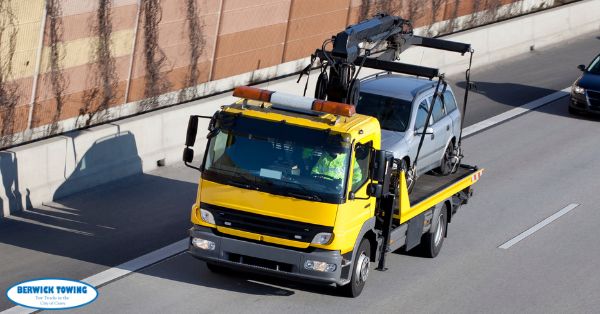Rotary towing and recovery is a type of towing that is used in the most extreme circumstances. But, even in regular situations, it offers advantages that many people are unaware of.
If you are looking for towing services and want to know more about rotator trucks, keep reading. The information below describes the functions and uses of a rotator vehicle. It also includes five situations where a tow truck with a rotator is helpful or even necessary.
What Is Vehicle Recovery?
When people talk about “vehicle recovery,” there can be some confusion, since it is a term often used to refer to tracking and repossessing stolen vehicles. This has no relation to the same terminology in the world of towing.
Very basically, recovery means removing a vehicle from a situation to get it back on the road for driving, towing, or otherwise hauling away. This could apply to a car ensnared in trees or guardrails. It could mean vehicles that have gone down a steep embankment and cannot be driven out on their own.
Vehicle recovery often means special equipment is needed to remove a vehicle. This can include things like saws or cutting torches. It also can refer to the use of special towing equipment to remove the vehicle.
Types of Tow Trucks
There are many different types of tow trucks out on the road. The most used are “hook and chain” trucks, although flatbeds are becoming increasingly common.
Flatbeds
As the name suggests, flatbed or “rollback” tow trucks have a flat surface on the bed for carrying vehicles. They use hydraulics to shift the bed up and down.
If it is possible to operate the vehicle involved in the accident, you can drive it onto the bed. If it is inoperable, the tow truck will use a winch with a chain to heave the vehicle.
These are popular because they are one of the most secure ways to tow a vehicle. However, a limitation is that they can only lift vehicles that are on a flat surface accessible to the rear of the truck.
Hook and Chain Tow Trucks
When most people think of tow trucks, they probably envision “hook and chain” trucks. These use a heavy-duty rivet suspended from a boon that lifts one end of the vehicle for towing down the road.
This type of towing is less secure than flatbed trucks since the car being dragged is more susceptible to damage, since parts of it could strike the ground while towing. Also, this method could damage the drivetrains of four- or all-wheel-drive vehicles. It can be a quick and easy way to haul junked vehicles.
Wheel-Lift Tow Trucks
Wheel-lift tow trucks are similar to “hook and chain” vehicles. They also hoist one end of the vehicle while allowing the other end to remain on the road. Instead of a hook and chain to secure the car, they rely on a metal yoke lifted by a hydraulic system.
One advantage of these trucks is that they do not put as much strain on the vehicle as hook and chain trucks. This can make them a good alternative if the vehicle is still in decent shape and not heading to the junkyard.
Integrated Trucks
Integrated tow trucks are the broad category of heavy-duty vehicles that specialize in recovery. They have self-contained systems that allow them to operate in even the most uncertain circumstances and environments. One of the most common types of integrated tow trucks is the rotary recovery vehicle.
What Is a Rotator Recovery Vehicle?
A rotary or “rotator” truck is a large tow truck that has a boom or crane affixed to its bed. As the name suggests, the boom can rotate in all directions. This allows them to access vehicles to the side and the rear of the tow truck.
Most rotator recovery trucks are heavy-duty, meaning they can lift very large, heavy vehicles or other equipment. Their ability to lift heavy, cumbersome vehicles, along with their range of motion and extensive reach, makes them ideal for circumstances where a regular tow truck will not suffice.
When Is Rotator Recovery Towing Necessary?
There are myriad situations where a rotator tow truck is definitely needed. Here are five common ones.
1. Large Vehicles
Most passenger vehicles weigh at least 5 to6,000 pounds, with many vans, SUVs, and heavy-duty trucks closer to 10,000 or even 15,000 pounds. Busses and utility vehicles can weigh much more, with many topping out at 30,000 pounds or more. Loaded-down 18-wheelers can weigh as much as 80,000 pounds.
While standard tow trucks are robust vehicles, they do have limitations on how much they can move. Even in ideal environments, it is easy to see how difficult it would be for a standard tow truck to move such heavy loads.
Rotary trucks are specifically designed for lifting very heavy vehicles. Many come equipped to hoist 70 tons or more, far beyond what most vehicles on the road weigh.
2. Uncertain Environments
Rotary tow trucks can offer big advantages in environments with uneven or unstable terrain. For vehicle recovery on steep embankments or in ditches, special equipment is necessary. It may be impossible for regular two trucks to access vehicles on the other side of guard rails or obstructed by buildings or trees.
The arms of rotary tow trucks can rotate 360 degrees and extend for 30 or more feet. This affords them greater access to areas that would otherwise be difficult or impossible to reach.
Anytime towing and recovery is needed, there is a risk for operators. Another big advantage of rotary tow trucks is that the driver can completely control the boom from the cab of the vehicle. This helps keep them safe by eliminating the need to venture out into uncertain terrain or circumstances on foot.
3. Harsh Weather
Inclement weather can make standard towing difficult or even dangerous. Snow, ice, or rain can limit traction for regular tow trucks, keeping them from accomplishing the job.
Rotator trucks are solid and have wide wheelbases. Sometimes they have an extra axle to increase stability, which can be especially useful in precarious weather situations. Also, their range of reach can help them avoid icy inclines and other dangerous surfaces altogether.
4. Difficult Angles and Tight Spaces
Power and challenging environments are not the only circumstances where rotary trucks come in handy. Another advantage is that they need less room to operate.
With many accidents, several lanes or even the entire road is closed or filled with emergency response vehicles. Because of their reach, rotary trucks can maneuver into tight spaces and perform recovery from vantage points that are impossible for standard tow trucks. You can even park them parallel to a vehicle it is accessing.
Regardless of size, overturned vehicles can pose a particular challenge to standard tow trucks. Rotary tow trucks, on the other hand, can grasp and remove cars that are on their sides or upside down.
This has the added advantage of not blocking space that could otherwise be used for emergency or other vehicles. It reduces the likelihood of traffic disturbances or getting in the way of first responders.
5. When There Are Time Limitations
Efficiency is another big advantage of rotary towing and recovery. Even if standard tow trucks can access a vehicle, it can take them a long time to get into the right position, secure the vehicle, and remove it.
Since rotary tow trucks can access vehicles from almost any height or angle, they can get into position quickly. Once there, the operator does not have to leave the vehicle or undergo the hassle of securing hooks or chains. They can engage the boom and begin recovery without further preparation.
This can be especially helpful in emergencies or where the vehicle is impeding traffic. Rotary trucks can complete the task in a fraction of the time it would take a standard tow truck.
Affordable Towing Services Company in Melbourne South Eastern Suburbs.
Berwick Towing & Transport located near the Beaconsfield Upper, Victoria 3808 Please check below map.
Berwick Towing & Transport
27B William Rd
Berwick VIC 3806
https://berwick-towing.com.au/
* Find us on Google Map

